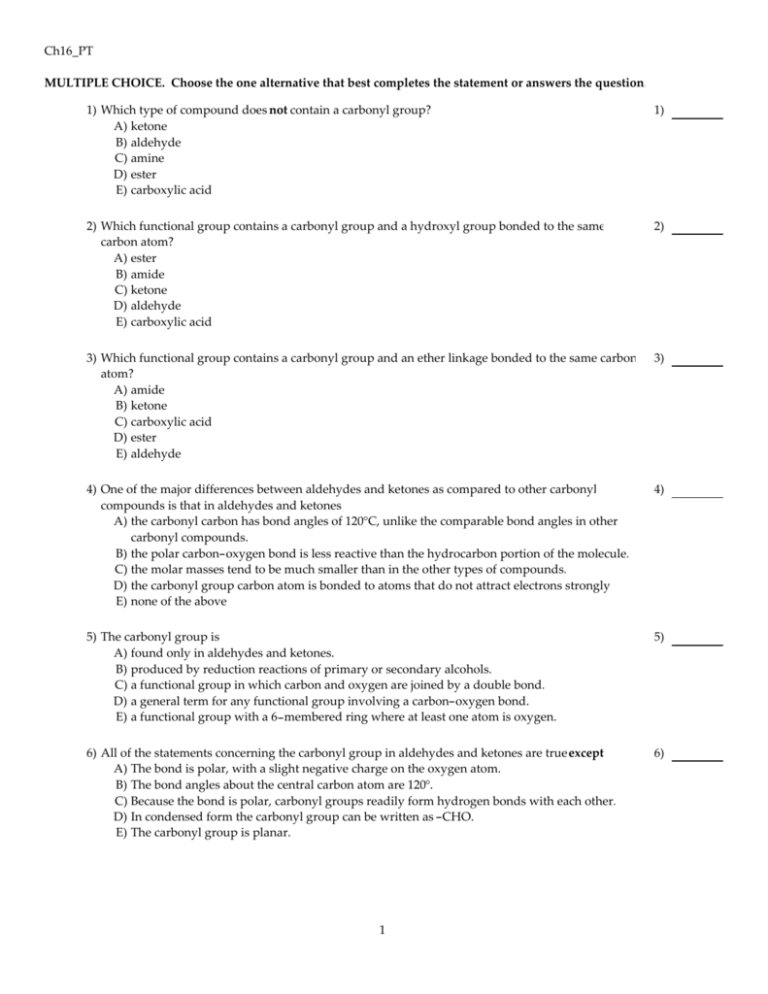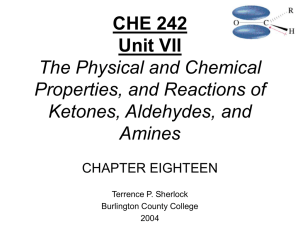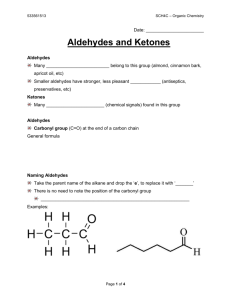Ch16 PT
advertisement

Ch16_PT MULTIPLE CHOICE. Choose the one alternative that best completes the statement or answers the question. 1) Which type of compound does not contain a carbonyl group? A) ketone B) aldehyde C) amine D) ester E) carboxylic acid 1) 2) Which functional group contains a carbonyl group and a hydroxyl group bonded to the same carbon atom? A) ester B) amide C) ketone D) aldehyde E) carboxylic acid 2) 3) Which functional group contains a carbonyl group and an ether linkage bonded to the same carbon atom? A) amide B) ketone C) carboxylic acid D) ester E) aldehyde 3) 4) One of the major differences between aldehydes and ketones as compared to other carbonyl compounds is that in aldehydes and ketones A) the carbonyl carbon has bond angles of 120°C, unlike the comparable bond angles in other carbonyl compounds. B) the polar carbon-oxygen bond is less reactive than the hydrocarbon portion of the molecule. C) the molar masses tend to be much smaller than in the other types of compounds. D) the carbonyl group carbon atom is bonded to atoms that do not attract electrons strongly. E) none of the above 4) 5) The carbonyl group is A) found only in aldehydes and ketones. B) produced by reduction reactions of primary or secondary alcohols. C) a functional group in which carbon and oxygen are joined by a double bond. D) a general term for any functional group involving a carbon-oxygen bond. E) a functional group with a 6-membered ring where at least one atom is oxygen. 5) 6) All of the statements concerning the carbonyl group in aldehydes and ketones are true except A) The bond is polar, with a slight negative charge on the oxygen atom. B) The bond angles about the central carbon atom are 120°. C) Because the bond is polar, carbonyl groups readily form hydrogen bonds with each other. D) In condensed form the carbonyl group can be written as -CHO. E) The carbonyl group is planar. 6) 1 7) Which molecule is formaldehyde? A) 7) B) C) D) E) 8) Which molecule is 2-butanone? A) 8) B) C) D) E) 2 9) Which molecule is propanal? A) 9) B) C) D) E) 10) Which molecule is acetone? A) 10) B) C) D) E) 11) Which is the correct systematic name for the molecule shown? A) ethyl methyl acetone B) methyl propyl ketone C) 4-hexanone D) propyl methyl ketone E) 3-hexanone 3 11) 12) Which molecule is a ketone? A) 12) B) C) D) E) 13) Which molecule is an aldehyde? A) 13) B) C) D) E) 14) The IUPAC name for acetone is A) 2-propanone. B) dimethyl ketone. C) 1-propanone. D) 3-propanal. E) 2-propanal. 14) 4 15) The IUPAC name for dimethyl ketone is A) 3-propanal. B) 2-propanone. C) acetone. D) 1-propanone. E) 2-propanal. 15) 16) The correct name for CH3 CH(CH3)CH2 CHO is 16) A) 3-methyl-1-butanone. B) 2-methylbutanal. C) 3-methylbutanal. D) isopentanal. E) 3-methyl-1-butanal. 17) The correct name for CH3 CH(CH3)CH2 COCH3 is 17) A) isobutyl acetone. B) 2-methyl-4-butanone. C) 4-methyl-2-butanone. D) 4-methyl-2-pentanone. E) 2-methyl-4-pentanone. 18) What is the IUPAC name of the compound shown? 18) A) 4-heptanone B) 2-methyl-3-hexanone C) 3-heptanone D) isopropyl n-propyl ketone E) 4-methyl-5-hexanone 19) What is the IUPAC name of the compound shown? 19) A) isopentanal B) 2-methyl-4-butanone C) 2-methyl-1-butanone D) 2-methylbutanal E) 3-methylbutanal 20) Which of the following names does not fit a real compound? A) 3-octanone B) 2-butanone C) 3-methyl-3-pentanone D) all are correct E) 3-methyl-1-pentanone 5 20) 21) Which of the following names does not fit a real compound? A) 3-ethylpentanal B) 4-methylpentanal C) all are correct D) ethanal E) 3-methyl-2-pentanal 21) 22) Which of the following is not a property of aldehydes and ketones? A) They cannot form hydrogen bonds with water because they have no hydrogen atoms bonded to oxygen. B) Most have distinctive odors. C) They have higher boiling points than alkanes of similar molar mass. D) They are polar. E) They have lower boiling points than alcohols of similar molar mass. 22) 23) All of the following are properties of acetone except A) flammable. B) intoxicating. C) solvent for organic substances. D) volatile. E) nutrient. 23) 24) Which of the following is a use of formaldehyde? A) flavoring B) preservative C) hormone D) solvent E) sweetener 24) 25) Which compound has the lowest boiling point? A) CH3 COCH3 25) B) CH3 CHO C) CH3 CH2 OH D) CH3 CH2 CH2 OH E) CH3 CH2 CHO 26) Which compound has the highest boiling point? A) CH3 CHO 26) B) CH3 CH2 CHO C) CH3 CH2 OH D) CH3 COCH3 E) CH3 CH2 CH2 OH 6 27) Which compound has the lowest boiling point? A) CH3 CH2 CHO 27) B) CH3 CH2 CH3 C) CH3 CH2 CH2 OH D) CH3 CH2 CH2 CH3 E) CH3 CH2 OH SHORT ANSWER. Write the word or phrase that best completes each statement or answers the question. 28) Arrange the following compounds in order of increasing boiling point: acetone, n-butane, propanal, 1-propanol, 2-propanol. Explain the reasons for your arrangement. 28) MULTIPLE CHOICE. Choose the one alternative that best completes the statement or answers the question. 29) All of the following are true concerning a two-carbon aldehyde except A) It has a higher boiling point than an alcohol of similar molecular weight. B) Its systematic name is ethanal. C) Its common name is acetaldehyde. D) Its condensed formula is CH3 CHO. 29) E) Its structural formula is: 30) All of the following are true concerning a three-carbon ketone except A) Its systematic name is propanone. B) Another acceptable name is methyl ethyl ketone. C) Its common name is acetone. D) Its condensed formula is CH3 COCH3 . 30) E) Its structural formula is: 31) The common name of an industrial solvent used in many manufacturing processes is methyl ethyl ketone. The correct systematic name and structural formula of this compound are A) 2-butanone; B) 2-propanone; C) 3-butanone; D) 3-butanone; E) none of these 7 31) 32) Tollens' reagent is used to A) distinguish amines from aldehydes. B) distinguish aldehydes from ketones. C) reduce aldehydes. D) reduce ketones. E) oxidize ketones. 32) 33) Oxidation of an aldehyde produces a A) primary alcohol. B) secondary alcohol. C) carboxylic acid. D) ketone. E) tertiary alcohol. 33) 34) Oxidation of a ketone produces A) an aldehyde B) a carboxylic acid C) a primary alcohol D) a secondary alcohol E) no reaction 34) 35) All of the following statements about oxidation of carbonyls are true except A) Oxidation of ketones produces esters. B) Tollen's test involves reduction of Ag+ . 35) C) Oxidation of aldehydes produces carboxylic acids. D) Benedict's test involves reduction of Cu2+ . E) none of the above 36) All of the following statements about oxidation of carbonyls are true except A) The Benedict's test involves reduction of Cu2+ . 36) B) Ketones do not react with mild oxidizing agents. C) The Tollens' test involves oxidation of Ag+ . D) Oxidation of aldehydes produces carboxylic acids. E) All of the statements are true. 37) Which compound will give a positive Tollen's test? A) pentanal B) 3-pentanone C) 2-pentanone D) pentanoic acid E) pentane 37) 38) Which observation denotes a positive Tollen's test? A) A silver wire dissolves. B) A brick-red precipitate forms. C) The light blue color of the reagent disappears. D) A silver deposit forms on the glass surface. E) Bubbles of oxygen gas are produced. 38) 8 39) Which observation denotes a positive Benedict's test? A) A mirror-like deposit forms from a colorless solution. B) A red precipitate forms from a blue solution. C) A red-brown solution becomes clear and colorless. D) A pale yellow solution with an odor of chlorine changes to a purple color. E) A purple solution yields a brown precipitate. 39) 40) What is the product of oxidation of butanal? A) butane B) 2-butanol C) 1-butanol D) butanoic acid E) no reaction 40) 41) What is the product of oxidation of 2-butanone? A) butanoic acid B) butanal C) 2-butanol D) 1-butanol E) no reaction 41) 42) Which compound will give a positive Tollen's test? A) 42) B) C) D) E) 43) What is product of the oxidation of a ketone? A) an aldehyde B) a hemiacetal C) a carboxylic acid D) an alcohol E) none, ketones don't oxidize. 43) 44) What is the element that causes oxidation in the Tollens test for aldehydes? A) gold B) copper C) lead D) silver 9 44) E) platinum 45) Reduction of an aldehyde produces a A) tertiary alcohol. B) carboxylic acid. C) secondary alcohol. D) ketone. E) primary alcohol. 45) 46) Reduction of a ketone produces a(an) A) carboxylic acid. B) secondary alcohol. C) aldehyde. D) tertiary alcohol. E) primary alcohol. 46) 47) What is the product of reduction of butanal? A) butanoic acid B) butane C) 2-butanol D) 1-butanol E) no reaction 47) 48) What is the product of reduction of 2-butanone? A) butanal B) 1-butanol C) 2-butanol D) butanoic acid E) no reaction 48) 49) What is the product of the reduction of 3-methyl-2-pentanone? A) 3-methyl-2-pentanal B) 2-methyl-3-pentanol C) 3-methyl-2-pentanol D) 3-methyl-2-pentene E) no reaction 49) 50) In biochemical reactions, reduction of carbonyl groups is carried out by A) H2. 50) B) lactic acid. C) NADH. D) pyruvic acid. E) NaBH4 . 51) Reduction of aldehydes and ketones is a A) one-step reaction involving the H- ion. 51) B) one-step reaction involving the H+ ion. C) two-step reaction involving the H- and OH- ions. D) two-step reaction involving the H- and H+ ions. E) two-step reaction involving the OH- and H+ ions. 10 52) What reaction conditions are needed to cause formation of an acetal from the same reactants that form hemiacetals? A) high temperature B) limited amount of alcohol as reactant C) metallic catalyst D) excess aldehyde or ketone as reactant E) acid catalyst 52) 53) The reverse reaction of acetal formation is A) oxidation. B) combustion. C) hydrolysis. D) reduction. E) esterification. 53) 54) Which pair of compounds can react to form a hemiacetal? A) CH3 CH2CHO and CH3 CH2 OH 54) B) CH3 CH2CHO and CH3 COOH C) CH3 COCH3 and CH3 COOH D) CH3 COCH3 and CH3 CH2 CHO E) CH3 COOH and CH3 CH2OH 55) A compound with an -OH group and an ether-like -OR group bonded to the same carbon atom is A) an acetal. B) a hemiacetal. C) a simple ether. D) an aldol. E) a diol. 55) 56) A compound with two ether-like OR groups bonded to the same carbon atom is A) an aldol. B) a hemiacetal. C) a simple ether. D) an acetal. E) a diol. 56) 57) Hydrolysis of an acetal will produce A) one aldehyde or ketone + two ethers. B) one aldehyde or ketone + two alcohols. C) one aldehyde or ketone + two waters. D) two aldehydes or ketones + one alcohol. E) two aldehydes or ketones + one ether. 57) 58) Since hemiacetals are unstable, they are seldom found in significant quantities in reaction mixtures. An exception to this statement is the formation of hemiacetals A) in an acid-catalyzed reaction. B) in a base-catalyzed reaction. C) from aldehyde and alcohol groups within the same molecule. D) from carbonyl compounds and alcohols with different R groups. E) from carbonyl compounds and alcohols with identical R groups. 58) 11 MATCHING. Choose the item in column 2 that best matches each item in column 1. Match the following. 59) methanal A) 60) ketone 61) propanone 62) aldehyde 63) carbonyl 60) B) a compound with a carbon atom that is bonded to two ether-like groups. 66) an example of a ketone 67) hemiacetal 68) acetal 69) an example of a hemiacetal 70) an example of an acetal 61) 62) C) a compound with a carbon atom that is bonded to both an alcohol-like group and an ether-like group. 64) an example of an aldol 65) an example of an aldehyde 59) 63) 64) D) a functional group consisting of a carbon group bonded to two other carbon atoms E) a functional group consisting of a carbonyl group bonded to one hydrogen atom and one carbon atom F) a functional group consisting of a carbon atom with a double bond to an oxygen atom 65) 66) 67) 68) 69) G) 70) H) the simplest aldehyde, also named formaldehyde I) CH3 CH2COCH2 CH3 J) the simplest ketone, also named acetone K) CH3 CH2CH2 CH2 CHO L) 12 Answer Key Testname: UNTITLED2 1) C 2) E 3) D 4) D 5) C 6) C 7) A 8) C 9) E 10) D 11) E 12) A 13) D 14) A 15) B 16) C 17) D 18) B 19) E 20) E 21) E 22) A 23) E 24) B 25) B 26) E 27) B 28) n-butane, propanal, acetone, 2-propanol, 3-propanol. (Students may reverse the placement of propanal and acetone. They are isomers, and text does not discuss differences in boiling points of aldehydes versus ketones.) Reasons: Molar masses are all similar, so that is not a major consideration. Thus the major considerations are polarity and hydrogen bonding. Butane is non-polar and has lowest bp. Acetone and propanal are polar, but do not form hydrogen bonds with themselves. The propanol isomers are polar and can form hydrogen bonds; the primary isomer can form stronger hydrogen bonds than the secondary isomer, so 1-propanol has the highest bp. 29) A 30) B 31) A 32) B 33) C 34) E 35) A 36) C 37) A 38) D 39) B 40) D 41) E 42) B 43) E 44) D 45) E 13 Answer Key Testname: UNTITLED2 46) B 47) D 48) C 49) C 50) C 51) D 52) E 53) C 54) A 55) B 56) D 57) B 58) C 59) H 60) D 61) J 62) E 63) F 64) L 65) K 66) I 67) C 68) B 69) A 70) G 14








